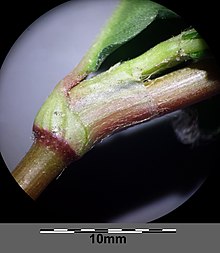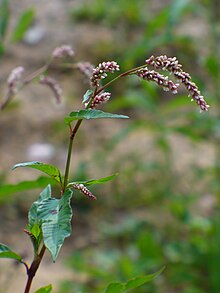Flea knotweed
| Flea knotweed | ||||||||||||
|---|---|---|---|---|---|---|---|---|---|---|---|---|

Flea knotweed ( Persicaria maculosa ) |
||||||||||||
| Systematics | ||||||||||||
|
||||||||||||
| Scientific name | ||||||||||||
| Persicaria maculosa | ||||||||||||
| Gray |
The flea knotweed ( Persicaria maculosa Gray , Syn .: Polygonum persicaria L. , Persicaria maculata (Raf.) Fourr. ), Also called peach-leaved knotweed , is a species of the knotweed family (Polygonaceae).
It is mainly pollinated by insects such as flies , hymenoptera and butterflies , but self-pollination can also occur. The long-lived seeds only germinate in light and are spread by humans, through digestion or through water (buoyant seeds).
description
The flea knotweed is an annual herbaceous plant that reaches heights of around 40 to 80 centimeters, rarely remains only 5 centimeters small or up to 130 centimeters tall. The flea knotweed has a branched taproot. It is rooted up to 35 centimeters deep. The stems usually grow semi-prostrate or upright, they are simple or branched, glabrous or somewhat hairy. The lanceolate leaves are four to six times as long as they are wide, they usually have a dark spot. His ochrea is hairy and has eyelashes about 2 mm long on the top. The petiole is usually shorter than half the width of the associated leaf. The leaf blade never has felt hair on the underside.
The cylindrical-eared inflorescences are densely flowered and about 10 to 45 mm (up to 60 mm) long. Its reddish or green flowers are about 3 mm long and cover each other like a roof tile. The bracts of the flowers have clear eyelashes. The shiny fruits look like a lentil, are convex or triangular on one side and are dark brown or black when ripe and 2 to 3 mm long.
The flea knotweed blooms from July to October.
The chromosome number of the species is 2n = 44 or 40.
Occurrence
The flea knotweed is circumpolar . It is originally found in the temperate zones of Asia, in Nepal and Indonesia and in European Russia. In other countries he is a neophyte .
It is a nutrient-demanding plant (strong nitrogen pointer) and can therefore mostly be found in ruderal areas influenced by humans . So it occurs frequently in damp fields, on rubble sites, heaps, roadsides or river banks in all of Central Europe except the Alps. In Central Europe it is a character species of the order Polygono-Chenopodietalia, but also occurs in societies of the order Bidentetalia or the Sisymbrion association.
In the Allgäu Alps, it rises on the Seealpe near Oberstdorf up to 1250 m above sea level.
Hazards and protective measures
Since no threats are known for this species, the IUCN classifies this species as Least Concern (low endangered).
Individual evidence
- ↑ a b Li Anjen, Alisa E. Grabovskaya-Borodina, Suk-pyo Hong, John McNeill, Hideaki Ohba, Chong-wook Park: Polygonum persicaria. In: Wu Zhengyi, Peter H. Raven, Deyuan Hong (Eds.): Flora of China . Volume 5: Ulmaceae through Basellaceae . Science Press / Missouri Botanical Garden Press, Beijing / St. Louis 2003, ISBN 1-930723-27-X , pp. 288 (English, online ).
- ↑ a b Harold R. Hinds, Craig C. Freeman: Persicaria maculosa. In: Flora of North America Editorial Committee (Ed.): Flora of North America North of Mexico . Volume 5: Magnoliophyta: Caryophyllidae, part 2 . Oxford University Press, New York / Oxford a. a. 2005, ISBN 0-19-522211-3 , pp. 593 (English, online ).
- ↑ a b c Erich Oberdorfer : Plant-sociological excursion flora for Germany and neighboring areas . 8th edition, page 337. Stuttgart, Verlag Eugen Ulmer, 2001. ISBN 3-8001-3131-5
- ↑ a b Persicaria in the Germplasm Resources Information Network (GRIN), USDA , ARS , National Genetic Resources Program. National Germplasm Resources Laboratory, Beltsville, Maryland. Retrieved August 14, 2017.
- ↑ Erhard Dörr, Wolfgang Lippert : Flora of the Allgäu and its surroundings. Volume 1, IHW, Eching 2001, ISBN 3-930167-50-6 , p. 452.
- ↑ Persicaria maculosa in the IUCN Red List of Threatened Species 2013.2. Listed by: Richard V. Lansdown, 2012. Retrieved May 15, 2014.
Web links
- Flea knotweed. In: FloraWeb.de.
- Distribution map for Germany. In: Floraweb .
- Polygonum persicaria L. In: Info Flora , the national data and information center for Swiss flora .
- Distribution in the northern hemisphere from: Eric Hultén, Magnus Fries: Atlas of North European vascular plants. 1986, ISBN 3-87429-263-0 at Den virtuella floran. (Swedish)
- Thomas Meyer: Data sheet with identification key and photos at Flora-de: Flora von Deutschland (old name of the website: Flowers in Swabia )




